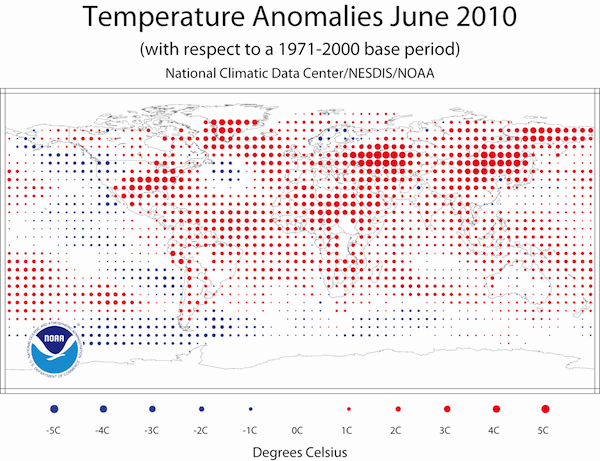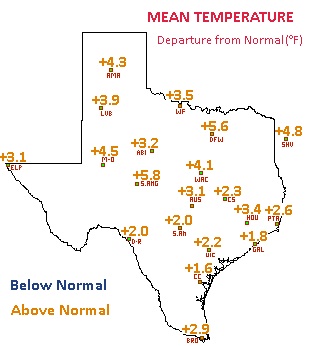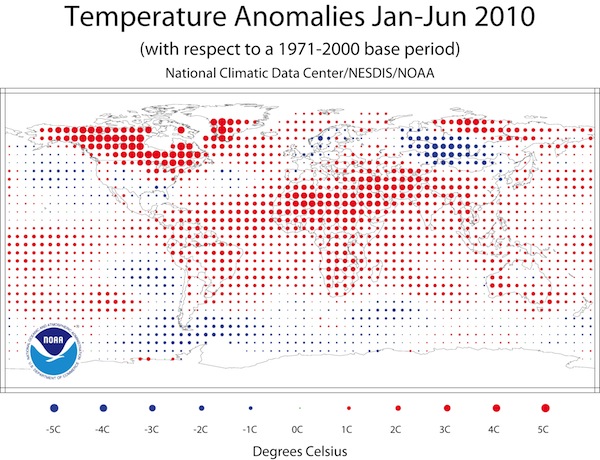By Bill Dawson

When he was in Houston to give a talk last December, the prominent climate scientist James Hansen of NASA told Texas Climate News that he thought 2010 could well turn out to be the warmest year ever.
“Next year is going to be very warm,” he said. “It could be the warmest year in the instrumental record.”
So far, temperature readings since Jan. 1 are proving Hansen correct.
On Thursday, the National Ocean and Atmospheric Administration announced that global measurements for the first six months of 2010 indicate that last month was the warmest June on record and that the April-June and January-June periods this year were the warmest ever recorded.
All of Texas had above-normal temperatures in June, the state climatologist reported separately.
The NOAA report was issued just a week after a heat wave gripped a large area of the East Coast from New England south to Virginia, grabbing media attention and, along with recently released studies, rekindling discussion about the connection between such events and scientists’ projections of a warming world.
Some of the details in the new NOAA report:
- Last month was the warmest June on record for both the average combined surface temperature of land and ocean areas around the world (1.22 degrees F above the 20th century average) and the land- only average temperature (1.93 degrees higher).
- The worldwide ocean surface temperature was the fourth warmest on record (0.97 degrees above the 20th century average), with this warmth most notable in the Atlantic Ocean.
- Warmer-than-normal temperatures in June were recorded around the world, with the most prominent warmth in Peru, the central and eastern U.S. states, and eastern and western Asia.
- The combined land-ocean average temperature for the last three months was the warmest ever recorded – 1.26 degrees warmer than the 20th century worldwide average for the April-June period.
- The worldwide land-ocean average for the first six months of 2010 was also the warmest ever recorded – 1.22 degrees above the average in the last century for January-June.
In a separate report, the Office of the Texas State Climatologist at Texas A&M University said June temperatures in Texas were above normal “across the entire state.”
Some highlights:
- The Dallas-Fort Worth area “was particularly hot, tying 2008 as the third warmest June on record and was just half a degree cooler than June 1980, which was the beginning of most severe heat wave in the history of the Metroplex.”
- Minimum temperatures in the DFW area, averaged over the entire month, were the warmest ever recorded for June.
- San Angelo was also especially hot, with average temperatures almost six degrees above normal and a maximum temperature nearly seven degrees above normal.
- “A historically hot stretch of weather brought extreme summer heat to West Texas” in early June, with record highs recorded in Midland and El Paso.
 As much of the Northeast was in the throes of a heat wave that brought 100-degree-plus temperatures to various locations last week, a NOAA scientist gave a preview of some of the data in that agency’s report on global temperatures and commented on what may lie ahead.
As much of the Northeast was in the throes of a heat wave that brought 100-degree-plus temperatures to various locations last week, a NOAA scientist gave a preview of some of the data in that agency’s report on global temperatures and commented on what may lie ahead.
“If the warming around the world continues the way it has so far this year, we are likely to have 2010 the warmest on record,” climatologist David Easterling told reporters in a conference call.
“We can’t say that one individual heat wave, or even two heat waves, are due to global warming but what we can say is that warming temperatures do increase the probability of a heat wave,” he said. “The current spate of heat waves could be a harbinger of things to come.”
Last winter, when snowy conditions dominated some of the same areas of the northeastern U.S. that experienced last week’s heat wave, global warming skeptics seized on the occasion to make fun of concerns about manmade climate change.
Republican Sen. James Inhofe of Oklahoma, who has claimed that the idea of human-caused warming is a “hoax,” was one of them, publicizing an igloo that some of his relatives had built in Washington that bore a sign saying “Al Gore’s New Home.”
Inhofe was notably silent about global warming during last week’s heat wave in the same part of the country, a number of commentators noted.
“Care to apologize to the Nobel laureate [Gore], senator?” asked columnist Eugene Robinson of the Washington Post, who observed that “it’s odd how little we’ve heard lately from skeptics who deny that climate change is real. What’s the matter, people? Heat stroke?”
Heat stroke was not portrayed as a laughing matter in a column by a professor of environmental planning at Georgia Tech that was published on CNN’s Web site last week, as high temperatures across the Northeast captured the attention of that cable network and other national media outlets.
Discussing a recently published study of his, Brian Stone wrote:
Extreme heat in major U.S. cities this week signals more than the arrival of the dog days of summer. City dwellers have long endured hot summer afternoons, but the frequency of extremely hot days – when admissions to hospital emergency rooms for heat-related illnesses spike – has increased substantially over the past several decades.
An analysis of weather records at Georgia Tech reveals that the average number of heat-wave days in large U.S. cities each year had increased from nine in the mid-1950s to 19 by the mid-2000s. The news is even worse for the country’s most sprawling cities, such as Atlanta, Georgia; Tampa, Florida; and Raleigh, North Carolina: The number of heat-wave days in these cities has nearly tripled during the same time.
Because of both global warming and also the localized urban effects of tree-loss, paving and other temperature-boosting activities, “most large American cities are warming at more than twice the rate of their outlying rural areas and the planet as a whole, and this accelerated pace is at the root of the increasing frequency of heat waves,” Stone wrote.
His was not the only research on heat waves to earn media attention last week. A Stanford University study used two dozen computer models to project the effects in the U.S. of an average global temperature increase of 1.8 degrees.
It concluded that that “exceptionally long heat waves and other hot events could become commonplace” in the U.S. over the next three decades.
“In the next 30 years, we could see an increase in heat waves like the one now occurring in the eastern United States or the kind that swept across Europe in 2003 that caused tens of thousands of fatalities,” said Noah Diffenbaugh, the lead researcher and an assistant professor of environmental Earth system science at Stanford, said in a statement released upon the study’s publication.
“By the decade of the 2030s, we see persistent, drier conditions over most of the U.S.,” he said. “Not only will the atmosphere heat up from more greenhouse gases, but we also expect changes in the precipitation and soil moisture that are very similar to what we see in hot, dry periods historically. In our results for the U.S., these conditions amplify the effects of rising greenhouse gas concentrations.”
The announcement of the Stanford study offered this context for the researchers’ projections for coming years: “The study comes on the heels of a recent NASA report, which concluded that the previous decade, January 2000 to December 2009, was the warmest on record.”

